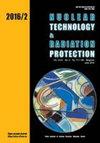用蒙特卡罗伽玛透射模型表征某些重金属氧化玻璃的多伽玛屏蔽参数
IF 0.9
4区 工程技术
Q3 NUCLEAR SCIENCE & TECHNOLOGY
引用次数: 0
摘要
通过表征前人制备的pbo - li20 - b2o3体系的6种玻璃样品模拟物的质量衰减系数、平均自由程和半值层,研究了简单蒙特卡罗伽玛透射模型的适用性。在0.107 MeV ~ 7.12 MeV的20条伽马能谱线范围内,计算了质量衰减系数,并与XCOM的衰减系数和现有实验数据进行了比较,得到了较好的一致性。计算了PbO浓度对质量衰减系数、平均自由程和半值层模拟值的影响,并与现有实验数据在0.356 ~ 1.332 MeV范围内进行了比较,结果吻合较好。对所有考虑的伽马能具有最佳屏蔽的玻璃样品是化学式为Pb3B4O9的样品。一方面,蒙特卡罗结果证实了所提出的模型对不同玻璃成分的光子衰减特性进行附加计算的适用性,另一方面,考虑到铀裂变过程中反应堆中伽马射线光子的能量范围为0.10-10 MeV,结果表明所研究的玻璃样品可以用作核反应堆的光学屏蔽窗。本文章由计算机程序翻译,如有差异,请以英文原文为准。
Monte Carlo gamma transmission model for characterization of multi-gamma shielding parameters of some heavy metal oxide glasses
The applicability of a simple Monte Carlo gamma transmission model was investigated by characterizing the mass attenuation coefficient, mean free path, and half-value layer for six glass sample simulants of the PbO-Li2O-B2O3 system previously prepared by others. The mass attenuation coefficients were calculated and compared with those of XCOM and the available experimental data for twenty gamma energy lines from 0.107 MeV to 7.12 MeV, and good agreement was obtained. The effects of PbO concentration on the simulated values of mass attenuation coefficient, mean free path, and half-value layer, were calculated and compared with available experimental data in the gamma energy range 0.356-1.332 MeV, and good agreement was found. The glass sample with the optimal gamma shielding for all considered gamma energies was the sample with the chemical formula Pb3B4O9. On the one hand, the Monte Carlo results confirm the applicability of the proposed model for performing additional calculations of photon attenuation properties for different glass compositions, and on the other hand, considering the energy range of gamma-ray photons in a reactor during uranium fission, 0.10-10 MeV, the results suggest the use of the studied glass samples as optical shielding windows in nuclear reactors.
求助全文
通过发布文献求助,成功后即可免费获取论文全文。
去求助
来源期刊

Nuclear Technology & Radiation Protection
NUCLEAR SCIENCE & TECHNOLOGY-
CiteScore
2.00
自引率
41.70%
发文量
10
审稿时长
6-12 weeks
期刊介绍:
Nuclear Technology & Radiation Protection is an international scientific journal covering the wide range of disciplines involved in nuclear science and technology as well as in the field of radiation protection. The journal is open for scientific papers, short papers, review articles, and technical papers dealing with nuclear power, research reactors, accelerators, nuclear materials, waste management, radiation measurements, and environmental problems. However, basic reactor physics and design, particle and radiation transport theory, and development of numerical methods and codes will also be important aspects of the editorial policy.
 求助内容:
求助内容: 应助结果提醒方式:
应助结果提醒方式:


